Abstract: This article documents the history of the Large Copper Lycaena dispar dispar (Haworth, 1802) in Britain. In doing so, it provides unpublished information from the journals and correspondence of James Charles Dale (1791-1872) from the archives at the Oxford University Museum of Natural History. An account is also given of the discovery of Lycaena dispar batavus (Oberthur, 1923) in Holland and its introduction to Britain.
Most of the records of L. dispar in Britain are from the fenland of Whittlesea Mere, where it was first recorded by J.C. Dale in 1819 (Dale, Entomological Calendar 1798-1835). Other localities historically given for L. dispar were Cambridgeshire (Haworth, 1802), Bardolph Fen in west Norfolk (Curtis, 1824), Suffolk (Stephens, 1828) and Benacre in the latter county by Jermyn in 1836. An early historic record of L. dispar from South Lincolnshire was also published by Redshaw in 1982. There are no reliable records from the Norfolk Broads, despite the area being well worked by many Norwich entomologists and naturalists (Barrett, 1874). Hudd (1906) provided an early record of L. dispar from Somerset by John Woodland of Taunton. Whether L. dispar ever occurred in Somerset is questionable, as there are no other authenticated records from that county.
In 1982, John Edward Redshaw, a member of the Spalding Gentlemen's Society, was reading old minute books when he came across a remarkable early record and painting of a male L. dispar. Redshaw (1982) wrote in the Transactions Lincolnshire Naturalists' Union: "In the Fifth Minute Book of Spalding Gentlemen's Society (Founded 1710), under the entries for 28th September 1749, appears the following report: 'The Orange Argus of Elloe, an Elegant butterfly depicted and discovered by the Secr'y. The Secretary Shew'd the Company a Butterfly which he took on the Dozen's Bank of which he sent a limming to Mr Da Costa to whom and to the Aurelian Society 'tis entirely unknown. Therefore, the President desired it might be sketched into the Book at his Instance the Sect was so obliging to make these very exact pictures thereof above'".
Redshaw (1982) recorded that "Mr Da Costa was Emanuel Mendes Da Costa (1717 - 1791), a notable naturalist of the period, Foreign Secretary to the Royal Society, and a member of the Spalding Gentlemen's Society. The limming is a coloured painting showing the upper and under surfaces of a large orange butterfly, to which is appended the scientific name of Argus Aurantius Elloensis. Although the wings are shown set unnaturally with the front edge at right angles to the thorax, the quality of the painting, in detail and in colour, leaves no doubt that the specimen was a male Large Copper. Dozen's Bank where the specimen was taken, presumably in the preceding July or August when this species is on the wing, is situated in the parish of Pinchbeck, and in 1749 formed the eastern boundary of the old Counter Drain Washes. This section of the washes was drained about 1775 when the Old Counter Drain was realigned to join the Vernatt's Drain in Pode Hole. Although these washes would have flooded in winter, it is likely that similar conditions were present in the Cambridgeshire Fens prior to drainage. Parts of the Pinchbeck South Fen section of the Counter Drain Washes probably remained unflooded throughout most winters. As the known 19th century colonies of this species appeared to be confined to comparatively small areas, it seems possible that the Pinchbeck specimen was taken within range of a local colony. More important is the fact that this note and painting in a 1749 Minute Book predates other records of the Large Copper Butterfly in Britain by some 46 years".
Redshaw did not name the Secretary who had captured the male L. dispar on the Dozen's Bank and wrote the entry in the minute book and added the limming. This was, in fact, the physician Dr John Green (1708-1756) who became the Society's Secretary in 1729 (Salmon, 2000).
In The Papilios of Great Britain, published in 1795, William Lewin (1747-1795) was the first to give details of L. dispar in Britain under the name hippothoe of Linnaeus, a specific name now attributed to the Purple-edged Copper. He gave the butterfly its English name of 'Large Copper'. Lewin, a fine illustrator who in 1776 described his profession as a painter, added figures of both sexes of L. dispar in his work, with the following text: "Some butterflies of this very rare species were met with by a gentleman in Huntingdonshire, on a moorish piece of land, and some were afterwards sent to Mr Seymour of Dorsetshire, who presented them to the late Duchess Dowager of Portland. They are now in the collection of J.J. Swainson".
Perceval (1983) revealed further details of the specimens of L. dispar mentioned by Lewin. When Henry Seymer's (1714-1785) annotated copy of the Aurelian by Moses Harris, published c1773, was discovered, Perceval found that Seymer had added drawings of both sexes of L. dispar to plate 34, with the name Papilio Plebeius ruralis Hippothoe Linn, and the note "till the year 1776 never seen, or at least taken in England; this specimen was then taken, with 5 or 6 more, in a fen in Cambridgeshire". The only discrepancy between Seymer and Lewin's account is the county where the specimens of L. dispar were taken. Henry Seymer Junior (1745-1800) coloured his father figures of L. dispar in the Aurelian in very fine detail, together with his drawings of Lycaena virgaureae [Scarce Copper] and the dark female form of Argynnis paphia [Silver-washed Fritillary], later to be named by Esper in 1800 as f. valesina. Plate 34 from the Aurelian, with Seymer's additional figures, was reproduced by Salmon (2000) in the Aurelian Legacy on page 287. It is not surprising that, with the butterfly undescribed and with no illustrations in any work, Seymer and later Lewin had thought the British species belonged to the Lycaena hippothoe of Linnaeus, who had described this species in the second edition of Fauna Svecica, published in 1761.
Barker and Vane-Wright (2007) reveal that Seymer wrote in his diary on the 28 November 1778: "To Mr Barton Wallop, thanks for 4 Hippothoe, 3 good". This is also certainly a reference to L. dispar as Seymer used Hippothoe for that species in his amended copy of the Aurelian. The Reverend Barton Wallop (1744-1781) lived at Over Wallop in Hampshire, and Barker and Vane-Wright (2007) suggested it was possible that these further specimens of L. dispar sent to Seymer came from that area of the Test Valley. However, Barton Wallop had a close association with Cambridge, and it is more probable that his specimens of L. dispar came from East Anglia.
Adrian Hardy Haworth (1767-1833), one of the fathers of British entomology, was also interested in botany and horticulture. Stearn (1965) provided biographical details of his life. Haworth was born into a wealthy family at Hull in Yorkshire. He first worked as an apprentice to a solicitor but, after receiving a large inheritance, he moved to Cottingham in the same county where he married and devoted his life to the study of natural history and gardening. In 1792, he settled in Chelsea to be near the centre of science in London. At Chelsea, then an affluent village, he came under the influence of William Jones (1745-1818), a lepidopterist and a fine illustrator. In 1801, Haworth established the third Aurelian Society, which lasted for five years, before becoming the Entomological Society. The Entomological Society published one volume of Transactions in 1812, but was dissolved in 1822. In 1812, Haworth moved back to his favourite town and garden at Cottingham, staying there for five years before returning to Chelsea. Haworth's most important work on entomology was the four volumes of Lepidoptera Britannica, published between 1803 and 1828. Haworth was married three times, his third wife survived him after he died of cholera in 1833.
 |
| Figure 1. A proof of a lithograph of Adrian Hardy Haworth in Roman classical style by the artist Weld Taylor. No other portrait is known to exist. |
When Haworth first captured specimens of L. dispar, he recognized the British butterfly was not the hippothoe of Linnaeus. On page 3 of his Prodromus Lepidopterorum Britannicorum (A Concise Catalogue of British Lepidopterous Insects), published in 1802, he wrote: "dispar, recently in England detected by me and my good friends W. Skrimshire and F. Skrimshire", with a footnote that it had been described as hippothoe by Lewin and Donovan. In the first volume of Lepidoptera Britannica, published in 1803, Haworth described dispar, keeping Lewin's name of the Large Copper, writing: "the butterfly in July frequents the marshes of Cambridgeshire in certain undeterminable years. That it is a new and very beautiful species to England, lately detected by me and his very dear friends W. Skrimshire and F. Skrimshire M.D., and formerly in Wales by the celebrated botanist Hudson; but nowhere in Scotland, as Donovan hath said from erroneous information". C. W. Dale (1903) writes: "Haworth, however, states that Hudson took this species in Wales. I think it far more likely that Hudson took it in the Fen Country".
Charles William Dale (1851-1906), the eldest son of J.C. Dale, stated in The History of our British butterflies (1890): "The Messrs Skrimshire first saw the coppers as they were going to Ely in a gig in 1797 or 1798, but took little notice. On returning they saw one settle on the road, and they knew it was not a common". This seems to be the first time that this information appears in the literature. It was not found during my research of the journals of his father, or in the correspondence with Haworth and Fenwick Skrimshire (1774-1855). J.C. Dale recorded in his Entomological Calendar (1798-1835) that he visited William Skrimshire (1766-1829), a surgeon in Wisbech, in 1819 and Fenwick Skrimshire, a physician at Peterborough, in July 1827.
John Curtis (1791-1862), in British Entomology (1824), wrote: "Dr Skrimshire took it many years since on Bardolph Fen". Curtis was sent records of insects for his British Entomology by William Skrimshire. Jermyn (1824) also gives Bardolph Fen as a locality for L. dispar. Bardolph Fen in West Norfolk is close to the county boundary of Cambridgeshire, as is Wisbech, where the Skrimshire brothers were born. William Faden's map of 1797 shows that there was a large area of undrained fenland to the east of Wisbech, comprising Bardolph Fen, with Marshland Fen to the north, and Downton Fen to the east. In July of 1819, J.C. Dale travelled from Whittlesea Mere in July, where he had gone to look for L. dispar, after hearing it had been seen there but, being unsuccessful in his search, he then went on to Bardolph Fen, as Dale was very keen to add specimens of the butterfly to his collection.
J.C. Dale recorded in his Entomological Calendar (1798-1835) that he was accompanied to Bardolph Fen on 29 July 1819 by two Wisbech naturalists, John Rose Whitehead (1787- 1849), a former apprentice of William Skrimshire and now practicing as a surgeon in partnership with him, and John Metcalf (c1771-1853), a solicitor who had married William Skrimshire's sister, Elizabeth. In Bardolph Fen, Dale recorded that he took two larvae of Papilio Machaon [Swallowtail] on Selinum (Peucedanum) palustre [Milk-parsley], both sexes of Locusta flavipes (a synonym of Stethophyma grossum [Large Marsh Grasshopper, that has since disappeared from East Anglia and is confined in Britain to the Poole basin of Dorset and the New Forest]) and Libellula quadrimaculata [Four-spotted Chaser], a common dragonfly. On the 30 July, Dale recorded the widespread dragonfly Aeshna grandis [Brown Hawker] in Bardolph Fen and saw it again the following day travelling from Wisbech to Ely. Although Dale did not capture any L. dispar in Bardolph Fen, his list of insects in his journal shows that the fen, or parts of it, remained undrained at that time.
C.W. Dale (1890) wrote of L. dispar: "In 1827, Mr Haworth took fifty specimens in a single day in Bardolph Fen, Norfolk". This is the first time this information appears in the literature - it was not found in his father's diaries, and it is surprising that there is no mention of it in Haworth's letters that he wrote to J.C. Dale in 1827. In July 1827, Haworth visited the Norfolk farm at Beachamwell, rented by his brother-in-law, Robert Scales (1765-1828), and his son John Scales (1794-1884), both keen naturalists and entomologists. In a letter dated 29 July 1827, Haworth wrote to J.C. Dale from Beachamwell: "At Whittlesea Mere I & Mr J. Scales & Mr Sparshall [Joseph Sparshall (1792-1837) a naturalist from Norwich] found hardly anything but a complete rainy day and were saturated with mud, wet and disappointment. We stayed but one day & went round by Wisbech to this place passing the old habitats of Papilio dispar now waving with corn". Haworth's letter reveals that the habitat where he had once collected L. dispar had, by 1827, been drained and cultivated. In August 1827, Haworth accompanied J.C. Dale to collect insects in the New Forest, and he was then a guest at Dale's Manor House at Glanvilles Wootton in Dorset.
Samuel Wells (1830) reported that the drainage of Bardolph Fen, comprising 5235 acres, was drained into the River Ouse by two principal mills that stood at the extremity of the fen next to the River Ouse, between Downton and Stow Bridge. The adjoining 7263 acres of the Marshland Fen that held waste water was also drained by two mills, and drains had been cut that also led into the River Ouse. Downton Fen to the east, 1600 acres in extent, was drained by two mills through Salter's lode directly into the River Lodge. The website Downham Market & Around, Local Parish Histories (2020), records: "Two engines were built in the mid-nineteenth century fairly close to one another. One pumped water out of the Downham Fen Drain into the Ouse a short distance from the other at the junction of Cuckoo Road and Ward's Chase, now marked by a clump of trees. The former, draining about 1600 acres, was erected c1842 and demolished about 1955 - rubble still marks the spot on the bank of the Ouse; the latter, draining 5235 acres, was commissioned in 1848, at a cost of £3500".
The first edition Ordnance Survey maps show the extent of unimproved Fenland of East Anglia with a shaded stippled area. The great extent of improved fens at sea level, that had been drained and cultivated, appear on these early maps as white areas. The Ordnance Survey maps published in 1824 show that there was unimproved fenland at Whittlesea Mere and to the north of Cambridge, such as Bottisham Fen, Burwell Fen and Wicken Fens. However, on the Ordnance Survey map of 1824 (Figure 3), showing Bardolph Fen, Marshland and Downham Fens, they appear in white - there is no sign of a stippled area showing any unimproved fenland, which is in marked contrast to Falden's Map of Norfolk of 1797 (Figure 2). William Falden (1750-1836) was based in Charing Cross, London, and was royal geographer to King George III. It is probable that the survey team at Ordnance Survey thought that, with the draining of Marshland Fen complete and the draining of both Bardolph Fen and Downham Fens in progress, they would soon be improved. The drainage of the Bardolph and Downton Fens seems to have been a protracted affair using windmills but, when two large steam mills were built in the middle of the 19th century, the draining was soon completed. However, often prior to any drainage, the fen vegetation was burnt (Bree, 1834, Henderson letter to J.C. Dale, 1841) - again making it unsuitable for L. dispar.
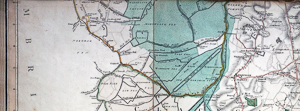 |
| Figure 2. William Falden's Norfolk Map of 1797 showing the large undrained area of fenland to the west of Downham Market, with Bardolph, Downham and Marshland Fens. |
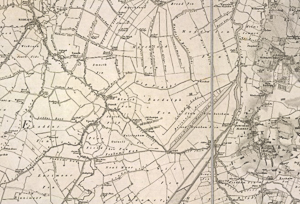 |
| Figure 3. The Ordnance Survey Survey Map of 1824 showing, Bardolph, Downham and Marshland Fens, would appear to show that the surveyors regarded those fens as improved. |
Haworth may have taken L. dispar in Bardolph Fen, but is the 1827 date of his captures, provided by C.W. Dale, correct? Dale was a knowledgeable entomologist, but some say that he was a much less meticulous recorder than his father. The notes of the late W. Curtis Parkinson were published on page 5 in Butterflies of Dorset by Thomas and Webb (1984). Parkinson writes: "C.W. Dale was notoriously careless in identification and transcription of records and with his abominable handwriting to boot"! This was found to be true during my research of the Dale collection. C.W. Dale often added his own labels to his father's specimens, and these are very difficult to read - in several instances, the date of the capture he added to a label is different to the one given by J.C. Dale in his journals. For example, on the data labels of the three specimens of L. virgaureae from the sale of the Haworth collection, C. W. Dale added the incorrect year of 1824, instead of 1834. Haworth's large collection of 40,000 specimens, containing many British and other types from around the world, was sold by J. C. Stevens' Auction House at 38 King Street, Covent Garden, the sale lasting eleven days. It is noticeable that, in the catalogue produced by Stevens for the sale of the Haworth collection, lot 1594 contained just four specimens of L. dispar that were sold on the eighth day of the sale, on Tuesday 1 July 1834. However, Haworth may have kept a short series of L. dispar specimens and used his duplicates for exchange.
In the Lepidoptera Appendices of Fenland Past and Present, Miller and Skertchly (1878) state, under the name Polyommatus hippothoe (dispar Haw): "Nearly eighty years ago Mr J.C. Dale recorded taking a specimen at Bardolph Fen, but the whole district has changed since then". This is an obvious mistake, as in the year 1798 Dale would have been seven, and still at school. The authors may have confused Dale with the Skrimshire brothers, or perhaps Haworth. According to the Cambridge University website (2020), the Reverend Leonard Jenyns from Bottisham near Cambridge recorded in his diary (no date given) that J.C. Dale had taken a single specimen of the Large Copper at Bardolph Fen. This would have been a substantial capture for Dale, who was a meticulous recorder, and it is not recorded in his Entomological Calendar 1798-1835. Dale recorded that he visited Jenyns at Bottisham in 1826, immediately after collecting at Whittlesea Mere, where he had taken a single male of L. dispar, his first specimen, which is probably the specimen that Jenyns is referring to. Entomologists in Britain were still having difficulty in determining the true identity of the hippothoe of Linnaeus. Edward Newman, in his celebrated work An Illustrated Natural History of British Butterflies (1871), referred to the Large Copper as Polyommatus hippothoe and he was followed by others, who mistakenly regarded the dispar of Haworth as a synonym.
The Reverend William Thomas Bree (1786-1863), a well-known naturalist of Allesley near Coventry, published in the Magazine of Natural History (1834) details of a letter he had received from Haworth. Bree writes: "The following fact, communicated to me by the late Mr Haworth. Some entomologists once made an excursion into the fen countries for the purpose of taking the beautiful Lycaena dispar, or large copper butterfly, which is well known, frequents low marshy grounds, the coppers were captured in good abundance. It so happened that the following winter the entire tract of land where the coppers had been found had completely inundated and actually lay under water for a considerable period. The entomologists deemed that the flood would certainly destroy the coppers, and the race would become extinct in that part of the country. The next summer, however, the butterflies were found again, in the very same spot, as plentifully as before. Subsequently, Mr Haworth informed me the tract of land was submitted to the action of fire, and the whole surface burnt with a view to agricultural improvement. I need hardly add that, after this operation, the coppers were no longer to be met with in that particular locality". It is a pity that neither Bree nor Haworth reveal the name of the L. dispar locality which was destroyed, and that the Skrimshire brothers or Haworth never published the name of the locality where they originally collected L. dispar.
Holme and Yaxley Fens, next to England's largest lake, Whittlesea Mere (in Huntingdonshire and now part of Cambridgeshire), had a rich flora and fauna that included many rare insects and were the last haunt of L. dispar in Britain. J.C. Dale, in his Entomological Calendar 1798-1835, recorded his first visit to Whittlesea Mere on the 16 June 1814, where he captured Papilio machaon. Dale seems to have been the first entomologist to have recorded P. machaon from the fenland of Whittlesea Mere, and in his Calendar of Captures and Gifts 1807-1812, to which he later added, there is further information regarding his captures of Papilio machaon at Whittlesea Mere in 1814. Dale writes: "saw them very plentiful. They were fond of settling on some ragged robin on the banks of a dyke. I went in a boat". Dale, who was attending Sidney Sussex College, Cambridge University, makes no mention that he knew this was a locality at that time for L. dispar.
Having heard that the Large Copper had been seen there, Dale visited Whittlesea Mere again in 1819. Although unsuccessful in his search, he met with Thomas Speechley of Yaxley, who later that year sent him the first specimen of L. dispar to be captured in that locality. In his Entomological Calendar 1798-1835, Dale provides a list of insects that he collected in the fenland of Whittlesea Mere, which indicates the rich biodiversity of that area at that time.
J.C. Dale recorded in his Entomological Calendar 1798-1835: "26 July to 11 August 1819, 55 Papilio Machaon - female dispar taken at Whittlesea Mere by Thomas Speechley of Yaxley, Hunts and sent to me by Dr Leach - British Museum". William Elford Leach (1791-1836) was the Assistant Keeper in the Natural History Department of the British Museum, responsible for the zoological collections. C. W. Dale (1890) gives the date of the capture of the L. dispar by Speechley as July 1819, and this female specimen is still to be seen in the Dale collection, with that date and Whittlesea Mere placed at its side. However, C.W. Dale (1903) wrote: "The first specimen known to have been taken at Whittlesea Mere - a female - was taken by Thomas Speechley, an old boatman in my father's employment, on August 4th 1819. My father had just returned from Whittlesea Mere without meeting any and told Speechley to take and send him any red-looking butterfly that he saw".
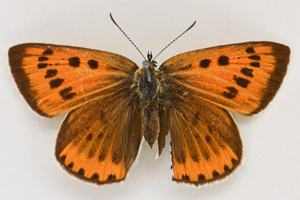 |
| Figure 4. The first specimen of Lycaena dispar captured at Whittlesea Mere in 1819 by Thomas Speechley. Dale collection, Oxford University Museum of Natural History. |
In 1820 Dale suggested to Benjamin Standish (1784-1866), a professional collector from London, that he should go to Yaxley Fen near Whittlesea Mere to search for L. dispar. Dale sent Standish £2 for his coach fare on the condition that he would have the first choice of any Large Coppers and other rare insects he captured. Standish payed his own expenses at Yaxley, staying at the Chequers Public House on Main Street. Standish's letters written from Yaxley to Dale in August 1820 and 1821 are a valuable record of the lost fenland and of the activities of an early 19th century entomologist. Standish came from humble circumstances, and his spelling and choice of words in his letters to Dale are not always what it should be - this probably reflects Standish's lack of schooling. I have corrected the spelling in the extracts of Standish's letters in this article where necessary to make them easier to read. In 1867, Newman wrote a short obituary of Standish in the January issue of the Entomologist, stating that he was a fine field worker and had good business sense - buying and renting properties in London, he was able to retire in middle age and devote the rest of his life to entomology, building up a fine collection of Lepidoptera. His fellow professional collector Henry J. Harding (c1804 -?) wrote of Standish in the Entomologist (1883): "He got a painting of the butterfly, coloured by his father, and went down to the fens and showed it to the people there, but no one knew anything about it". Benjamin's father, Joseph Standish (1753-1837), was a well-known entomologist and a fine painter of Lepidoptera.
The following are extracts from letters written by Benjamin Standish to J.C. Dale.
Yaxley, 5 August 1820. "I did not receive your letter dated the 24 July before the 31 July, my father received the parcel a few days before I received your letter brought me the £2 most safe. I started at Snow Hill London on the Wednesday, August 1, afternoon at 6 o'clock and arrived within three quarters of a mile of Yaxley. The next morning August 2, at half past 6 that day Mr Speechley took me to the spot where he took the Large Copper, but the wind blew so hard and very strong and with little sun we could not see anything on the wing. The next day, August 3, I went out by myself and about the spot where the Large Copper was taken, on the other side of the river, I saw three Swallowtails. I went over and caught two. I took 7 that day, four of them were very fine, and the same day I took four dozen of the larva, and several of the large green Chrysomela [J.C. Dale added a note to the letter this was C. fulgida, a synonym of Chrysolina graminis, Tansy beetle], and I have taken 40 in all. I could not expect to beat much, the wind being so very strong. I took 7 of which I think is the Gold Spot (Plusia festucae). I am much obliged to you for the £2 pound you sent for my coach expenses, and I am sorry I have not taken any Large Coppers for you, I thought I saw it yesterday August 4, but I was not certain. I am afraid I will not see it without the weather getting still and calm which I am afraid it will not be before I shall come to my exit and be obliged to go home, but at any rate I shall be here three or four days longer". Chrysolina graminis is listed as critically endangered and was thought to be extinct in East Anglia, being confined to the River Ouse near York, but a population was recently rediscovered at Woodwalton Fen NNR (Buglife, 2014).
Yaxley, 9 August 1820. "I have the pleasure of informing you that after being here 7 days I have found a famous place for the Large Copper, this morning about half past 10 o'clock I saw a Large Copper about 30 yards of me and caught it, it is a female. I have taken three females, but they are not so fine as I could wish. One of them is very fine except a piece out of the underwing, but I think they're being so much wind as to batter them, but I think if I had a still day I would be able to get you sir a good set of them, which I very much wish to do. I shall be here 3 or 4 days longer. I saw 4 specimens besides the 3 that I have taken. The spot that Mr Speechley showed me for the Large Copper is a little way into the fens, on this side of the river opposite what they call the holt where the willows are and a little lake [J.C. Dale added a note to the letter that this was Trundle Mere, which was connected to the western edge of Whittlesea Mere by a short channel of water], but this spot I found out is the most likely place about the fens I have been to. I have been about a quarter of a mile beyond the mere, beyond the large willow tree. I thought Mr Speechley was very shy in directing me to the different areas in the fens. A man asked me what particular butterfly I was after, I told him a Large Copper. I said I should be very much obliged to him if he would show me the spot as he was going to work there and I would satisfy him for his trouble but he said he would not tell me the place, he said he did not know why he should take them himself. Mr Speechley told him I would give him 2 shillings for each one I took if he would show me the spot, but he would not, but the next day I got a man to show me where he worked but I could not see any there, it was not so likely a spot as I found them since, but this man showed me a great deal about which I satisfied him for. I have taken 30 Swallowtails and 130 larvae. I have taken 4 male (Lymantria) dispar [Gypsy moth], but it is wasted and seen several more". This was the first capture of the extinct British race of The Gypsy moth L. dispar at Whittlesea Mere.
C.W. Dale (1903) contains an extract from the letter written to his father on the 9 August 1820, but also added additional commentary from Standish in the letter: "Mr John Drake of the Chequers Inn, where I stayed, told me a man lodged there who worked in the fens, cutting reeds, who was the most likely person to know the best localities. However, he would not tell me, and said that he did not see why he should not take them himself and make money of them as well as Mr Speechley". This extract was not found in the original letter dated 9 August, and it is probable that C.W. Dale wrote this himself from the information provided by Standish in the letter to his father. Standish, who did not receive a reply from Dale, wrote again from London in case had not received his letter.
Walworth, London, 21 August 1820. "I take the liberty of acquainting you that I left Yaxley on the 14 of August. I was there six days before I saw anything of the Large Copper, the weather there being so very bad. I made up my mind to leave the night before ... but the next morning being very fine although windy I went to the mere again and found a famous spot where I took three female Large Coppers and saw 4 others but could not take them the wind was so high, in a day or two before I got a man to show me about the Meres, which I satisfied him for. Sir I have taken 8 females and 4 males. Sir, I was 12 days at Whittlesea Mere thinking I might get better specimens, but there is a fine male and one very large female. The spot that Mr Speechley showed me I could not see anything of it. I think it was a chance thing that it flew there. Next Summer I shall go after the Large Coppers again, if please God I have my health and can save up some money sufficient to go there. Sir, if I get better specimens I will change yours".
Standish was able to return to Yaxley in August 1821 and, in the following letter he wrote to Dale, gives further details of his search for specimens of the Large Copper.
Yaxley 4 August 1821. "I have the pleasure of informing you I arrived at Yaxley on the 3 August at 6 o'clock and was in the Meres about half past 7 o'clock till a little before 6pm. I was not there long before I took the Large Coppers, several worn. I was then very sorry but howsoever as luck as fell to my share at last this summer I took 8 incomparable specimens, in fact they are so very fine I cannot describe their beauty to you, Sir. I shall have the best specimen for you. There is a large and fine male upperside and one very small female. I have taken three other scarce insects". J.C. Dale added a note to this letter that these were the Laelia coenosa [Reed Tussock], the first adults of this extinct moth to be taken in Britain. Dale had found a larva of L. coenosa on the 25 July 1819, but it had died. Standish returned to the fens of Whittlesea Mere in 1822, 1824, and 1826, and he met Dale there on the 21 July 1827, when he also collected the pupa and larva of L. dispar.
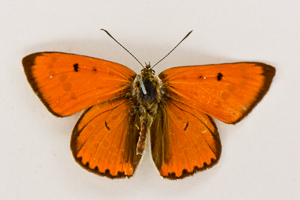 |
| Figure 5. Male Lycaena dispar. Dale coll, Oxford University Museum of Natural History. |
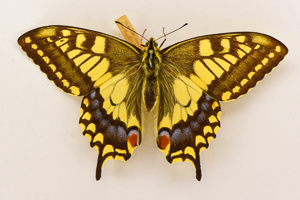 |
| Figure 6. Papilio machaon caught by Standish 7 August 1820. Dale coll, Oxford University Museum of Natural History. |
C.W. Dale (1903) wrote: "My father went down to Whittlesea Mere in 1826, and took his first specimen, a fine male, close to Warble Pit on June 25th. He payed others visits in July 1827, and July 1833". In his Entomological Calendar 1798-1835, J.C. Dale recorded that Warble Pit was also known as White Pit, and this is marked on the Ordnance Survey maps of 1824, showing that it is very close to the western edge of Whittlesea Mere. This is likely to have been an old water-filled peat digging. J.C. Dale gives the date of his first capture of L. dispar in his Calendar as 26 June 1826. He also recorded at Warble Pit on the 24 June 1826 the Norfolk Hawker Anaciaeschna isocelesisosceles, a rare and protected dragonfly in Britain that is now confined to the Norfolk Broads and north east Suffolk. On 9 July 1926, Dale received a box of insects from Speechley with several specimens of L. dispar.
Dale visited Whittlesea Mere the following year where, on 18 July 1827, after nearly treading on an adder, he took two male and one female L. dispar, and collected the larva of Papilio machaon. On 20 July 1827, he took a pair of L. dispar and met with Benjamin Standish. Dale's last visit to Whittlesea Mere was in 1833, when he collected two female specimens of L. dispar on 4 July.
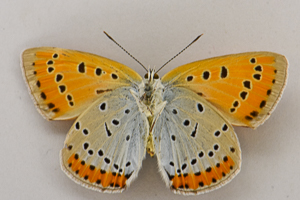 |
| Figure 7. Female Lycaena dispar specimen Whittlesea Mere, July 1833. Dale coll. Oxford University Museum of Natural History. |
When Henry Tibbats Stainton (1822-1892) ceased publication of the Entomologist's Weekly intelligencer in 1862, three avid readers (the Manchester schoolboys Thomas Blackburn (1844-1912), his brother John Bicketon Blackburn (1845-1881), and their friend Edmund Martin Geldart (1844-1885)), published the Weekly Entomologist on behalf of the Bowden and Altrincham Entomological Society (which mainly composed of themselves). They wrote to Stainton for financial aid who agreed to help, and they contacted other well-known entomologists to contribute articles, including J.C. Dale. The Weekly Entomologist appeared between 1862 & 1863, but when Stainton withdrew his support the journal discontinued.
In a letter to the Weekly Entomologist of 26 September 1862, J.C. Dale writes under the heading 'Notes by an old entomologist':, "I can recollect the time when L. dispar used to be taken. The first specimen seen in London was sent to me from Whittlesea Mere, (where I had been seeking it unsuccessfully) to the care of Dr Leach at the British Museum, and that gentleman wanted me to go there again. I was, however, obliged to go home, just in an opposite direction. In the following year I went to Whittlesea again, and as August was said to be "the time" I was rather surprised, when I saw what I had supposed to be a very brilliant moth flying around me several times, but which proved when captured, to be a male of L. dispar, this being in June. I afterwards sent B. Standish to the locality, who after an unsuccessful week, was about giving it up as a bad job. He was on his way to Stilton, en route for London, when as the sun shone out brightly, he turned back, and captured some specimens of the long looked for dispar".
Dale's statement in the Weekly Entomologist that he had gone to Whittlesea Mere in June 1820 and captured L. dispar is surprising, and one wonders if his note to the journal was written in haste and he confused his dates. There is no reference to this capture of L. dispar in his Entomological Calendar 1798-1835, and his entries in that journal reveal that, in June 1820, he was at Glanvilles Wootton and there is no record of him being at Whittlesea Mere that year.
In the Entomological Magazine (1834), James Francis Stephens (1792 -1852) listed a remarkable collection of butterflies that he had made in various localities in July 1833. At Whittlesea Mere he recorded "5 and 6 July Lycaena dispar in plenty; 4 and 5 July Papilio Machaon; 4-6 July Pieris (Aporia) crataegi [Black-veined White] in great plenty, but going off; 4 and 5 July Argynnis aglaia [Dark Green Fritillary] plentiful". Stephens also recorded that A. crataegi was in plenty in Monks Wood. It is surprising that J.C. Dale did not record A. crataegi from Whittlesea Mere.
Joseph Henderson (b? -d 1866), the head gardener to Viscount Milton Charles William Wentworth Fitzwilliam (1786-1857) of Milton Hall near Peterborough, recorded in his letters to J.C. Dale and John Scales (the nephew of A. H. Haworth) information regarding the improvements of Yaxley Fen in the 1840s and the substantial threat to L. dispar when the larva were discovered in 1825 on the Great Water Dock (Rumex hydrolapathum). Large numbers of the larva were collected by the local population for sale to dealers, some of who came to fill their boxes (Wheeler, 1892). The human predation of the larvae and pupae came at a time when the fens of Whittlesea Mere were already drying because of drainage (Henderson's letter to J. Scales, 1826).
Newton (1885), in his biography of John Scales, published a letter written to Scales by Henderson from Milton on 28 August 1826. Henderson writes: "You are perhaps not acquainted with the fact that the larva of dispar has been discovered, with the plant upon which it feeds, Rumex aquaticus (a synonym of Rumex hydrolapathum). Last year the gardener from Holme Wood and a Mr Wood of Huntingdon discovered the larva on Dock. They took a number of them home and succeeded in breeding a good many of the perfect insect. The gardener at Holme sent me some of the chrysalises (which are very curious, having much the appearance of some shells you find attached to the reed) to forward to Curtis [entomologist John Curtis] who happened to be here at the time and took them with him for the purpose of being figured. Standish has been in the fens during all the dispar season and has taken a great many but I do not think he got anything new. The Fens are getting more dry, and the people are cutting more of the grass and sedge than they did some years ago, and it is probable that in a few years it will cease to be a habitat for those rare insects which had been previously have been found there. Arctia (Laelia) coenosa have not been taken, either larva, or fly this season". The gardener from Holme Wood was W. Whybray, who was employed by Lady Elizabeth Wells at Holme Hall (Dale, Travel Diary 1827-1830). Dale wrote the following entry for 20 July 1827 in his Entomological Calendar 1798-1835: "40 Lycaena dispar bred from larva by Whybray a gardener at Holme".
Newton (1885) also gave details of a letter sent to Scales by Edward Bidwell, a head gardener and afterwards forester to Lord Fitzwilliam. Bidwell states: "In Mr. Henderson's garden, there was a spring so arranged as to supply a small pond, round which he cultivated roots of the Bulrush; and, bringing home from the Fens larvae of the Large Copper Butterfly, he placed them among the plants so that they might effect their final change, and sometimes there would be several of the perfect insects flying round the pond at once".
John Curtis, in British Entomology (1823-40), wrote: "it is with much pleasure I have been able to give figures of the Larva and Pupa; they were communicated to me by Mr Henderson, of Milton, with the following remarks "Messrs Whybray and Wood found the caterpillars in May and June 1826. Mr W. [Whybray] says that they are found in the greatest plenty the first three weeks of June, about the time they change to chrysalides, and remain in that state about three weeks: it is supposed that the eggs remain through the winter, and are probably hatched about the latter end of May. The caterpillar feeds on Rumex aquaticus and other docks in captivity found in the fens, and the chrysalis is attached to the back of the leaf-stalk near the bottom". Curtis issued British Entomology in parts between 1824 & 1840 (the first part appeared in January 1824, although 1823 appears in the volumes) in no particular order, with a complete set of volumes with the parts placed into the different insects orders in 1840 (Dunbar, 2010). Curtis' plate of L. dispar is dated 1824. The pupae and larvae of L. dispar were added to the revised plate, which appeared in volume 5 of British Entomology in 1840.
Henderson wrote to J.C. Dale on the 4 March 1831: "Such immense numbers of the larva of L. dispar have been taken during the spring of 1828 & 1829 that I fear the habitat will be totally destroyed. They are taken by every labourer residing near the fen. I went to the Fens one day last summer; the insect was on the wing but found them very scarce indeed".
Other entomologists also recorded the human predation of larvae of L. dispar in the fenland of Whittlesea Mere. Wheeler (1892) wrote: "Salmon in his diary under the heading 'Yaxley, 13th May 1836' has the following: Phillips says that he obtained threepence per dozen for the caterpillars of the Copper Butterfly (Lycaena dispar); a few seasons ago he collected thirty dozen for one person". Harding (1883) writes of L. dispar: "Two men from Cambridge came later and took a large number to London, where they were sold at sixpence each. Three years later I went down myself and took the larva. They were very local, and were collected by all persons, young and old. I bought two dozen of an old woman for ninepence and sold them for a shilling each. Mr Cole at Holme Fen, had a large quantity, but the last time I went he said he had not seen it for some years".
Henderson wrote to Dale on the 14 June 1841: "I have at last procured for you a number of chrysalis of Lycaena dispar which are sent with the box, they are in probability the last you will ever receive from the Whittlesea Mere fens as the draining and other improvements going on will so leave no food for the rare insects which have formerly been found in that place". In a letter dated 19 June 1843, Henderson wrote: "I expected young Low here to gather larvae of the Copper butterfly, but he has not made an appearance yet. I understand the insect is getting scarce and confined to our localities, where the ploughing and burning have not yet destroyed the dock. Many attempts have been made of late years by the proprietors of the Middle Level to obtain an Act of Parliament for a general drainage of the level towards the Ouse at Lynn, and which would include thorough drainage of Whittlesea Mere, the proprietors are however so much decided on the details of the measure that it is not likely to be undertaken just yet".
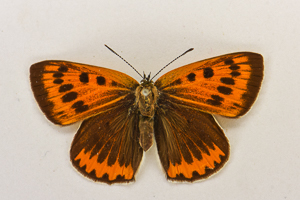 |
| Figure 8. A female specimen of Lycaena dispar that emerged from a pupa on the 23 June 1841. Dale collection, Oxford University Museum of Natural History. |
John William Douglas (1814-1905) recorded of L. dispar in 1859: "I made a pilgrimage to Whittlesea Mere in 1841, on purpose to see the beauties alive, but it rained every day during the week I was there, and I only saw a solitary specimen which ventured to open its wings during a transient gleam of sunshine. Now whenever I look at that butterfly in my cabinet, the recollection of the moment when it flashed its glory before me comes like a new pleasure". Henry Doubleday (1808-1875) wrote of L. dispar in the Zoologist (1841): "Caterpillars of this species very plentiful in Holme Fen on water dock Rumex Hydrolapathum". Doubleday (1841) also recorded the Marsh Fritillary (Euphydryas aurinia) in Holme Fen and discovered the Reed Leopard Moth (Phragmataecia castaneae) there, writing: "of the insect which is new to Britain, I found a single male floating on the water in a dyke on the border of Holme Fen". Lee Melville of Magdalen College, Cambridge, reported in the Zoologist (1843)" "Lycaena dispar. Reared several fine specimens from larvae found in May 1842 on water-docks, at Whittlesea Mere". In July 1844, Doubleday wrote to J.C. Dale that he had bred 47 L. dispar. Many of Doubleday's specimens of L. dispar are in the collections of the British Museum of Natural History.
Wheeler (1892) recorded: "I have no means of fixing accurately the date of Mr Brown's [Thomas Brown, a collector and dealer from Cambridge, who is mentioned in entomological journals of that period] first acquaintance with Yaxley, but from various incidents of his conservation I imagine it was at least prior to 1844. He told me that in his time the fen-men always asked a shilling each for a pupa or good specimens of the butterfly. Bearing in mind that the Norfolk reed-cutters usually offer Swallowtail pupae at one penny each, and the Wicken men ask only twopence each for them, we may infer that at that time the supply was decidedly limited".
Frederick Bond (1811-1889) wrote in Newman (1871) of L. dispar: "The latest capture, consisting of five specimens, was made by Stretton, in either 1847 or 1848; they were all purchased by Mr Harrington. I was at Yaxley for several successive years after that, but never saw another specimen, or heard of another being taken". J. F. Dawson of Ventnor on the Isle of Wight, who spent two days collecting Coleoptera in Holme Fen in 1848, reported in the Zoologist that year: "Lycaena dispar has become very nearly extinct: I could hear of only five larvae been taken, and very few of the perfect insects appeared that season". Bree (1851) recorded: "A collector and dealer at Yaxley informed me in the summer of 1848, that he had that season most diligently searched up and down all the dykes, and could scarcely find a single caterpillar; he had, I think, only one specimen of the butterfly in his boxes".
William Wells (1729-1805) of Holme Hall was granted permission in 1775 by Parliament to drain Holme Fen and erect windmills to lift the water into the rivers (Holme History, 2015). The water level at Whittlesea Mere became lowered through drainage and, during the dry summer of 1826, the mere completely dried out (Heathcote, 1876). In a survey conducted in 1835, the engineer Sir John Rennie found the depth of Whittlesea Mere to be considerably lower than it has been and that parts of the Mere bed were overgrown with reeds scarcely a depth of six inches in the water (Middleton, 2018).
When William Wells died, Holme Hall and its estate came into the possession of his wife, Lady Elizabeth Wells, and their son, William Wells (1826-1889), managed and then eventually inherited the estate. William Wells Jr and other landowners (Lord Saye and Sele of Farcet, the Dean and Chapter of Peterborough Cathedral and the Earl of Carysfort) gained an Act of Parliament in 1844 to drain Whittlesea Mere (Holme History, 2015). Middleton (2018) gives details of the final drainage of Whittlesea Mere and its fenland. This began in 1845 with the construction of northern Black Ham River. This diverted the water of the Nene from the mere into the 17th century drain Bevill's Leam. Wells installed an Appold centrifugal pump that he had seen at the Great Exhibition of 1851 and that year Whittlesea Mere was drained, with the water run off into the Black Ham River. A few years later Wells bragged: "wind which in the summer of 1851 was curling the blue waters of the lake, in the autumn of 1853 was blowing in the same place over fields of yellow" (Middleton, 2018). The wealthy landowners were overjoyed with the increased revenue from the crops sown into the rich mud of the former Mere, and the London Illustrated News joined in their elation, writing on 26 April 1851: "After having been accustomed for so many years to see Whittlesea Mere as nothing but a flat scene - fenny, watery, swampy and unproductive - it will be almost starting to see, at the touch of the genius of improvement the water flow into canals, the swamps become green pasture grounds, the fens flooded with a golden sea of ripened corn, and farms and homesteads gathering round them the treasures of the soil"! (Middleton, 2018).
The draining of Whittlesea Mere and its fenland proved to be the last in a long series of ecological disasters that befell the rich fauna and flora of the English fenland. Not everyone was pleased with the loss. E. W. Cooke, in a letter written in 1875 to the artist and author John Moyer Heathcote (1800-1892), says: "I was never more surprised than when I saw the present state of the fenland, as compared to its former condition, when Whittlesea Mere was quite a scene of interest to the visitor; both to the painter, sportsman, and the naturalist. One now looks in vain for the broad expanse of water reflecting the grey, passing clouds, and margined with vast masses of Arundo phragmites [Common Reed], sedges, and other marsh loving plants" (Heathcote, 1876).
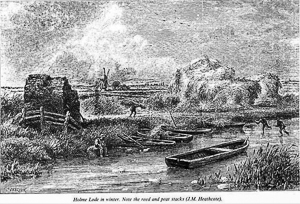 |
| Figure 9. Holme Lode in Winter with peat and reed stacks by J.M. Heathcote 1824. |
In an article in The Phytologist (1850), entitled 'Recollections of a morning ramble in the Whittlesea Fens' in July 1840, the Reverend W.T. Bree wrote: "Whittlesea Mere is a rather awkward place to go to see, for, being surrounded to a large extent by a tract of perfectly flat fenny country, and screened, moreover, by a phalanx of tall reeds near the margin of the water, the nearer you approach the lake itself, the less able are you to get a view of it. Indeed, we might have rambled, I believe, the whole morning in the Fens without ever seeing the Mere at all, had not our considerate guide directed us to a spot where we could just get an imperfect peep at it. The splendid Lycaena dispar, one while captured here abundantly is now, I am told, scarcely, if at all, to be found in this locality. Its existence in Britain will probably ere long be a matter of history, one of the things which were, and are not. The Whittlesea Satin moth too Laelia coenosa, I was told used to be found in certain parts of the fens, but had not been met with of late years".
When L. dispar became extinct in Britain, it was soon realized that, although they were a few notes of its capture in the entomological journals, not a single entomologist had published any details of its habits in its fenland home. Some of those who had encountered the Large Copper at Whittlesea Mere realized that further details of their encounters with the butterfly might now be of interest. In Stainton's Manual of British Butterflies and Moths, published in 1857, Frederick Bond writes: "You are quite right in supposing that I have had a personal acquaintance with living Dispar. I much fear that I shall never have that pleasure again, as I am quite sure they have disappeared from the Cambridge and Huntingdonshire Fens. All I can tell you about their habits is this - that they were very active and shy, and would only fly when the sun shone; they would settle on a thistle when they could find one in bloom, flying off to attack any insect, no matter what, that might come anywhere near them; not always returning, but generally passing on to another place. It was very little use following them if you missed your first stroke with the net, as they went like the wind, and seldom let you get a second chance, indeed it was difficult to follow them, as keeping your eyes on them and the boggy places was a rather difficult job". Wheeler (1892) writes: "I might add to this sketch a note of Mr Bond's (communicated by Professor Newton), that in his experience the larvae (L. dispar) were to be found only on those plants of the Rumex hydrolapathum which grew in water".
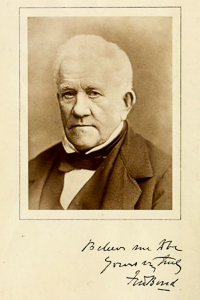 |
| Figure 10. A photograph of Frederick Bond from the Zoologist (1889). He had an extensive knowledge of the Lepidoptera of the fenland. |
The Reverend E. F. C. Jenkins (1807-1881), the vicar of Billinghay Vicarage, Sleaford, Lincolnshire for forty-seven years, wrote to the Entomologist's Weekly Intelligencer (1857) in an article that was addressed to the editor, Stainton, under the title 'Lament for the Large Copper': "I therefore proceed to give you some account of my own acquaintance with that most beautiful insect which, some thirty years ago, was so abundant in the unreclaimed fens about Whittlesea Mere that I never expected to hear of its utter extermination. Its brilliant appearance on the wing in the sunshine I shall never forget, and to watch it sitting on the flower of Eupatorium cannabinum [Hemp-agrimony] and show the underside of the wings, was something ever to be remembered. I took sixteen in about half an hour in one particular spot, where the above-mentioned plant was very plentiful; but unless the sun was very bright they were difficult to find. In those days the larva was unknown, and I attribute the discovery of the larva, to the unceasing attacks of collectors, and to the burning of the surface-growth of the fens, which is done in dry weather when they are about to be reclaimed. Thirty years ago the fens about Whittlesea Mere were most interesting localities for the entomologist, the botanist and the ornithologist. I lived then in the neighbourhood, and those pursuits were my delight. Papilio Machaon might be had in any amount; the flight of Chysophanus dispar was very plentiful in July; the moth L. dispar [Lymantria dispar] was very plentiful; besides many other rare and beautiful insects. Now, however, everything is totally changed. The Great Northern Railroad runs through part of the fen where, when I was a boy; one could scarcely walk: at the spot I used to land from my boat, on the edge of the Mere, stands a farmhouse; my favourite locality for C. dispar - where the bog myrtle used to grow in profusion and the scent the air with its delicious perfume - (as I myself saw last season) converted into a field of stinking cole-seed, with a flock of sheep eating it off. All the better, no doubt for the landowners, but ruinous work for the naturalist, and as such you will sympathize with me in the destruction of what was one of the most interesting country for persons inclined to such pursuits - you will understand how indignant I felt when someone irreverently told me, a few years ago, that they had tapped the Mere"!
Samuel Stevens (1817-1899) seems to have been more concerned with a missed money money-making opportunity than the extinction of the L. dispar, writing in the Science gossip (1894): "I well remember at the meeting of the British Association at Cambridge, in the year 1844 or 1845, I was introduced by Mr Vernon Wollaston, or Rev. Hamlet Clark, to a man the name of Rawlinson "the Pie-man" as he was called. He used to go out for gentlemen of the University, to collect for them in the Fens, plants, insects, and other objects of Natural History, in the summer time: but in the winter he sold pies. Rawlinson asked me if I wanted caterpillars of the large copper; I said I could do with a few. Two days afterwards he bought me a dozen. I told him six would be enough, which I purchased of him at the price he asked, sixpence each. I took them home and bred five fine and perfect specimens. At that time one could buy the butterfly from Argent and other London dealers at 1s and 2s each. Now, in consequence of the drainage of the Fens, the insects is no longer to be found, and fine and perfect specimens at recent sales have realized £5 to £6 each. If one could only anticipated what has happened, I should certainly have taken a dozen caterpillars and laid in a large stock of butterflies, for a little fortune might have been made out of them".
Miller & Skertchly (1878) recorded in the Fenland Past and Present: "In 1851, the year Whittlesea Mere was drained, Mr Wagstaff took a solitary specimen at Bottisham Fen". The record by Wagstaff of L. dispar from Bottisham Fen is mentioned by Howarth (1973) and Thomas & Lewington (2014). However, my research has shown the record of L. dispar from Bottisham Fen by E. Wagstaff of Chippenham in Cambridgeshire to be doubtful. Charles Cardale Babington (1808-1895), an eminent botanist, visited Bottisham Fen in 1844 and found it almost dried up through drainage (Crompton, 1997). Bottisham Fen would appear to have been an unsuitable habitat for L. dispar by the time of Wagstaff's record. As this article shows, Bottisham Fen was visited by some very distinguished naturalists, many of whom were entomologists and L. dispar was not previously recorded from that locality.
The entomologist and botanist Reverend Leonard Jenyns (1800-1893) was born at Bottisham Hall. Biographical details of Jenyns were provided by Crompton (1997). Jenyns became interested in natural history before going to Eton in 1813, where he gained a particular fascination with Gilbert White's A Natural History of Selborne. In 1817, Jenyns went up to St John's College, Cambridge, where he met John Stevens Henslow (1796-1861), a professor in Mineralogy and later a Regius Professor of Botany, who became his brother-in-law in 1823. Both men had a common interest in Natural History and, in 1818, both began their herbariums. Jenyns, like many botanists of that period, was also a keen entomologist. J.C. Dale visited Jenyns in July 1826, and they collected insects together for several days. From 1823, Jenyns was the Curate at Swaffham Bulbeck (a parish next to Bottisham) and, in 1828, he was appointed vicar there and moved into his newly rebuilt Vicarage House. Jenyns' journals dated 1826-46 are held by the University of Cambridge. Jenyns first recorded collecting in Bottisham Fen in 1823, and he visited that locality many times, often in the company of Henslow. Jenyns' journal provides no records of L. dispar occurring in Bottisham Fen. Christ's College Cambridge University website (2020) records "Unfortunately few, if any, of Jenyns' butterfly and moth specimens still survive".
Crompton (1997) gives some entries from Jenyns' journal of his visits to Bottisham Fen. Jenyns wrote on 13 June 1823: "This morning I went down into the Fens beyond Anglesey Abbey, for the purpose of collecting Machaon butterflies. What specimens I did get were very much torn. This is singular and must perhaps be attributed to the sharp reeds and sedge, which abound in those parts, and are much frequented by this noble species of Papilio". On 11 May 1825 he wrote: "This morning I strolled down into the fens beyond Anglesey Abbey, to see what was out in the Botanical & Entomological way, but did not notice much. Saw a single Machaon". On 4 July 1825, Jenyns writes: "While botanizing in Bottisham Fen today in company with Professor Henslow, we made a discovery of another of the Orchidere new to this district; - this was nothing less than the Ophrys (Liparis) Loeselii Linn [Fen Orchid] a plant which I have long coveted, & moreover suspected might be found in that place if diligently sought for at the proper time of year, which till now I never had an opportunity of doing. The event has realized my expectations. It was not however in any abundance, as our most indefatigable researches could not procure more than five specimens".
Henslow's famous botanical excursions from Cambridge with his pupils started in 1827. In his diary, Jenyns describes many of the trips to Bottisham Fen and those to the north at Burwell and Wickens Fen. P. machaon seems to have been abundant at both Wicken and Burwell Fens, but L. dispar was never recorded from there, perhaps because the foodplant R. hydrolapathum was scarce in those fens. Burwell Fen was drained by the landowner in 1848 (Crompton, 1997). Henslow is best known for being Charles Darwin's pupil and mentor while he was at Cambridge's Christ's College. John Medows Rodwell (1808-1900), a fellow pupil of Darwin's, recollected a visit to Bottisham Fen on one of Henslow's excursions and an amusing incident involving Darwin: "In order to clear the ditches we were provided with several jumping poles with which we had to swing ourselves across. One object of our search was to find the Utricularia [bladderworts, a genus of carnivorous plants] a specimen of which caught his keen eye, and in order to secure he attempted to jump the ditch on the opposite side of which it grew. Not however, having secured sufficient impetus for the leap, the pole stuck fast in the middle in a vertical fraction, of course with Darwin at the top. Nothing daunted however, he coolly slid down, secured the prize, and brought it, all much besmirched as he was to the amused Professor" (Christ's College Cambridge University website, 2020). Darwin recollected: "Henslow used to take his pupils, including several of the older members of the University, on field excursions, on foot, or in coaches to distant places, or in a barge down the river, and lectured on the rarer plants or animals which were observed. These excursions were delightful" (Crompton, 1997). John Curtis also accompanied Henslow on one such visit to Bottisham Fen (Crompton, 1997).
After the last of the British Large Coppers spread their brilliant wings in the fens of Whittlesea Mere in 1848, it is not surprising that collectors wanted to be the first to re-discover the butterfly elsewhere, which led to a bizarre range of dubious records and localities appearing in the journals, where the butterfly was seen but never captured.
When a Mr George King advertised in the January 1858 issues of the Zoologist and the Naturalist insects caught last season in the fens, it included specimens of L. dispar. The Reverend Henry Harpur-Crewe (1828-1883) of Stowmarket, in a letter to the Naturalist, wished for more information on the locality where King had taken his L. dispar specimens. King, a dealer from Torquay, had called on Harpur-Crewe and his friend C.R. Bree (an editor of the Naturalist) in 1857 after collecting in the marshes at Horning and showed him his box of insects from that locality, that later appeared in his adverts, but there had been no specimens of L. dispar. In his reply to Harpur-Crewe in the Naturalist, King stated that his L. dispar specimens were from an old collector, now dead, who had collected them at Whittlesea Mere, and he tried to appropriate the blame for the mis-information that appeared in his adverts to the editor of the Zoologist, Edward Newman, who had nothing to do with the Naturalist. King stated: "I know of a person in the fen (Horning) who reported that he took one hundred and fifty (L. dispar) in the year 1856". This muddled excuse did not please Harpur-Crewe and he again he pointed out in the Naturalist that King had stated he took L. dispar in the past season in his adverts placed in the two journals, and that Horning was a well-worked locality with no records of L. dispar, writing: "Mr King puts himself into a worse position than ever, and into the bargain proves that E. Newman made a blunder in 1857, and a gentleman an astounding falsehood in 1856".
After these exchanges in the Naturalist, Stainton, the editor of the Entomologist's Weekly Intelligencer, wrote in that journal in 1858 under Fen Insects: "We believe the impression is a very general one that the glorious old days of undrained fens and extensive swaps are gone, never to return and that the Large Copper is now in England, as unlikely to be met with us as the Dodo, A controversy going on, in the pages of a monthly periodical, on the important question of whether the Large Copper, might, could, would or should have been taken; and if it might, could, would or should have been taken, when it might could or would or should have been taken, and where it might, could, would or should have been taken. We trust, however, the writers will have recourse to the net, rather than to the pen, to decide the knotty question". However, most of the dubious records of L. dispar appeared in the Entomologist's Weekly Intelligencer. James Tutt (1903) writes: "Mr J. B. Hodgkinson, of Preston, states in the Entomologist's Weekly Intelligencer, vol iv, p. 10 (1858) that he saw a specimen in Cumberland, that he took a very deliberate look at it and lost it after all. This set the ball rolling, for in the same Magazine, p. 131, Mr W. Winter of Ranworth, says: 'This species has again appeared in the fens here; I saw four yesterday and missed them all. This was on June 19th, 1858. I doubt whether any one of these (and others not mentioned) has a suspicion of probability in it'".
A.G. Irwin (1980) stated that he found, in a cabinet of butterflies at an auction, two specimens from the Norfolk Broads, labelled Ranworth 1860 and Woodbastwick 1864. However, with the absence of verified captures from that region, information placed on data labels, especially as British specimens of L. dispar are more valuable with data, is no guide to authenticity. Charles Golding Barrett (1836-1904), in his list of Lepidoptera of Norfolk (1874), published in the Transactions of the Norfolk and Norwich Naturalists' Society, omits L. dispar from the county altogether, writing: "Stephens (Illust. 82) gives Norfolk as one of the localities for this species, but there is no reliable record of its occurrence here, and he was probably misinformed". Barrett's comments are surprising as Curtis (1824) states that Skrimshire took it in Bardoph Fen. However, the list of Lepidoptera provided by Barrett does show that Ranworth, Woodbastwick and the other Norfolk marshes were well worked by many reliable field workers with no specimens of L. dispar ever being captured there by them.
The male and female L. dispar in the William Jones (1745-1818) collection at the Oxford University Museum of Natural History appear to be the earliest known extant specimens. Jones, a wealthy wine merchant, is best known for the unpublished Jones' Icones (c. 1779-1818), which comprises 1,500 very fine watercolours of butterflies and some moths bound in 6 volumes, from the world collections of Dru Drury, Joseph Banks and John Francillon. The Jones Icones, manuscripts and specimens from his collection were donated to the Oxford Museum of Natural History between 1925 and 1938 by a descendant, Fredrick Dawtrey Drewitt (1848- 1942) (Santry, 2014). Vane Wright & Drimmer (2010) suggest that the L. dispar specimens in the Jones collection may have been bought at the sale of the Henry Seymer or Duchess of Portland's collections. The Duchess of Portland's collection was sold at her Whitehall residence from 24 April to 3 July 1786 and the Seymer collection the same year (Wright & Dimmer, 2010). However, Lewin (1795) states that the specimens of L. dispar in the Duchess of Portland collection sent to her by Seymer went into the collection of J. J. Swainson. The Jones L. dispar specimens may have been brought at the sale of the Seymer collection, but it is possible they came from his friend and fellow Chelsea resident Haworth. Elizabeth Dennis Denyer (1765/6-1824), who also lived at Chelsea, produced watercolours at the suggestion of Jones of some British Lepidoptera in his collection, that included his female specimen of L. dispar. Denyer's unpublished Paintings of Lepidopterous Insects (c1800), bound in a single volume, was presented to the British Museum.
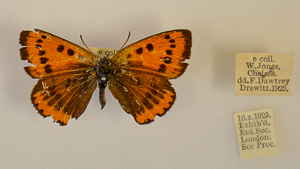 |
| Figures 11. Lycaena dispar specimen in the William Jones Collection. Oxford University Museum of Natural History. |
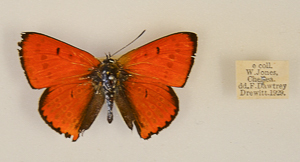 |
| Figures 12. Lycaena dispar specimen in the William Jones Collection. Oxford University Museum of Natural History. |
J.C. Dale (1834) recorded in the Magazine of Natural History and Journal of Zoology that he took two males at Trundle Mere, the forewings of one being long and acute, the other short and obtuse, but, apart from size, they differed little. There is variation within the female of L. dispar specimens in the brightness of the copper colour. However, extreme aberrations were very rare in this species. C.W. Dale (1894) recorded that the Manchester collector Joseph Sidebotham had a female that was silvery white, as in Lycaena phlaeas [Small Copper] ab. schmidtii. An aberration of L. dispar in the Sidebotham collection in the Manchester Museum has the left forewing silvery white (Figure 13). There is an extreme melanic female aberration of L. dispar in the Dale collection that is labelled 'J.C. Dale From Simmonds' (Figure 14). William Simmonds was a friend of Joseph Henderson and was the confectioner to Viscount Milton Charles William Wentworth Fitzwilliam. When Simmonds visited Milton from London, he and Henderson collected insects together (Henderson correspondence to J.C. Dale 1826-1841).
There are still many genuine specimens of the extinct British L. dispar in national and provincial museums, and in private collections. The collection of Large Coppers in the Oxford University Museum of Natural History and the British Museum of Natural History show that, during this period, even those at the pinnacle of entomology and revered men of science such as H. Doubleday, J.F. Stephens, H.T. Stainton, F.W. Hope and others added no data to their specimens. The few specimens with locality data all appear to be all from fenland of Whittlesea Mere. Unfortunately, a number of specimens mostly seen in private collections have dubious data. These specimens always seem to have excellent data, unlike the old museum specimens.
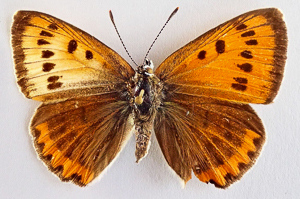 |
| Figure 13. An aberration of a British Lycaena dispar in the Joseph Sidebotham collection, Manchester Museum. |
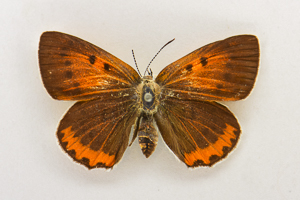 |
| Figure 14. A melanic aberration of Lycaena dispar in the Dale collection, Oxford University Museum of Natural History. |
Charles Rothschild (1877-1923) announced at a meeting of the Entomological Society on 6 October 1915 the discovery of Lycaena dispar in Holland, which was said to indistinguishable from the lost British race (Wheeler, 1915). Janssen (2015) gave details of the discovery. Meerten Warmolts, a teacher at a school in Scherpenzeel in Friesland, had sent some butterflies collected by one of his pupils at Lindevallei near Wolvega to Rudolf Polak, who managed the Artis insectarium in Amsterdam. Polak was surprised to find L. dispar among them. At first, Dutch entomologists (who called L. dispar the Grote vuurvlinder, the Large Fire Butterfly) kept the locality a secret, for fear that the butterfly would be over- collected.
Norman Riley (1890-1979) of the British Museum was sent a series of three males and four females of L. dispar batavus, stating in the Entomologist (1820): "In size and general colouration there is to my mind, nothing to distinguish them from dispar. There are however, the following small constant differences: (1) In both sexes the marginal red band on hindwing underside is consistently narrower than in dispar; it is also consistently broader than in other continental races I have examined. (2) The black spots on the underside, especially of hindwing, are consistently smaller in dispar. (3) In the male the black marks in all and at the cell-end on the upperside of the forewing are consistently smaller in dispar. (4) The hind margins of the forewings below in both sexes are invariably greyer than in dispar, in which are usually brownish. (5) The tendency in the female for the black spots in the band on the upperside of the forewing to be produced towards the base of the wing in long rays is apparently very pronounced in Dutch specimens. (6) The ground colour of the forewings below in both sexes is slighter paler than in dispar, but not so pale as in ordinary Continental form".
Henry Rowland Brown (1865-1922), in a reply to Riley's notes, recorded in the Entomologist (1921) that Charles Oberthur (1845-1924) wrote in the Bulletin de la Société entomologique de France, No 15, p. 254-5 (1920): "Finally, the C. dispar, conforming absolutely to the extinct English race, has been discovered in Holland. I have been able to compare a superb Dutch male, for which I am indebted to the courtesy of R. Van Eecke, of the Leyden Museum, with old English examples included in my collection. It appears to me impossible to determine any difference between the Dutch and the English C. dispar". It is therefore surprising that Oberthur named the Dutch race L. dispar batavus in 1923 in Etudes de Lépidoptérologie comparée Vol.21 (2), p.73, writing: "the Dutch race should be given a name to indicate its origin to distinguish it from the English race". Emmet (1990) wrote that L. dispar batavus differs from the nominate subspecies: "On the hindwing underside, the white-ringed black spots are smaller, especially in the basal area. On the hindwing underside, the orange band is narrower and less squared at its apical extremity".
Charles Rothschild (1877-1923), a pioneer of nature conservation in Britain, purchased Woodwalton Fen in 1910, one of the first nature reserves, intending to present it to the National Trust, but they declined. Woodwalton Fen was all that remained of the great wetland around Whittlesea Mere. Rothschild initially kept Woodwalton Fen as a private reserve and he built a bungalow there for himself and his guests (Great Fen website, 2020). In 1927, L. dispar batavus was released into Woodwalton Fen. At first it proved to be successful, and a release was made at Wicken Fen in 1929 & 1930, though this colony only survived for around 12 years (Colvin, 2013). It was found that the butterfly needed human maintenance at Woodwalton Fen, that included breeding in cages with fresh stock from Holland. The butterfly died out there in 1969, but other introductions were made. It was concluded that the site was too small to support to a viable breeding population naturally, and the butterfly was eventually left to its own devices, dying out again in the 1990s (Thomas & Lewington, 2014).
Ford (1945) writes of L. dispar batavus: "drainage schemes and irresponsible collecting after its presence was made known, was on the verge of extinction within a few years in its known localities". It was lost to the original site, Lindevallei in the Netherlands (now a nature reserve), in 1971, but a small population survives in Rottige Meente, with the largest population present in the Weerribben National Park. However, it has been lost to the Wieden area of that park in the south (Janssen, 2015).
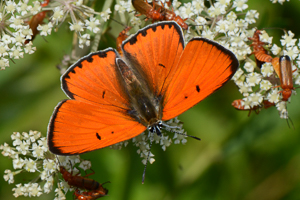 |
| Figure 15. Lycaena dispar batavus male. Weerribben National Park, Holland, August 2015. Author. |
I would like to thank James Hogan of the Entomology Department at the Oxford University Museum of Natural History for permission to access the collections. Kathleen Santry and Danielle Czerkaszyn at the archives of the Oxford University Museum of Natural History, and Dmitri Logunov of the Manchester Museum for the image of L. dispar from the Sidebotham collection.